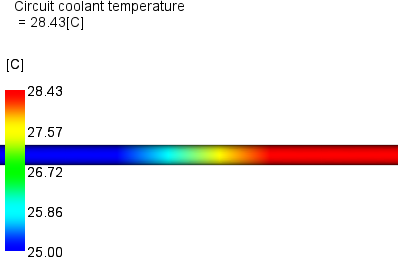Coolant Flow analysis
Coolant Flow is a new analysis that enables you to rapidly simulate the fluid behavior in your cooling circuit, without the additional time required to analyze the part and mold.
The Coolant Flow analysis is supported for all mesh types:
 3D
3D Dual Domain
Dual Domain Midplane
Midplane
| Analysis sequence | Mesh type |
|---|---|
Coolant Flow |    |
Once you have optimized your cooling circuit performance, mesh the part and mold and run your Cool analysis with your optimized cooling circuit.
Limitations
The Coolant Flow analysis is available for beam elements only. For 3D channels, extract the channel center lines and mesh the extracted curves as beam elements.
New Results
To help you understand the performance of your circuit design, and to help you decide upon the pump specifications needed to attain that performance, two new results are available.
Circuit minor loss coefficient result
The circuit minor loss, or K factor, is the resistance to flow that occurs in the cooling circuit as a consequence of every elbow, bend, T Junction, expansion, contraction, etc. Historically, the software has calculated an approximation for the circuit minor losses, and used these values in the Cool analysis simulations. With this result, you can actually view the calculated approximations and where they are in the circuit, you can choose to enter specific values from the component manufacturer, or you can instruct the software to ignore minor losses.
Circuit friction factor result
The friction factor determines the frictional losses in the circuit, and is dependent upon the equivalent sand grain roughness factor (e/D) of the channel and the Reynolds number, Re, of the fluid flowing through it. The default equation for calculating the friction factor is the Swarmee-Jain equation, but you can choose from several others if you prefer, and compare the results from the different approximations.
Use these new results, in conjunction with the existing Circuit coolant temperature, Circuit flow rate, Circuit pressure results to get a thorough understanding of the circuit behavior.
For example:

Figure 1: Coolant temperature either side of an element with heat transfer information.
